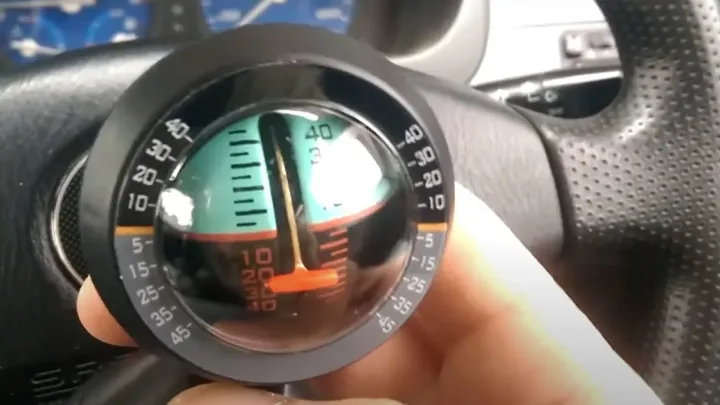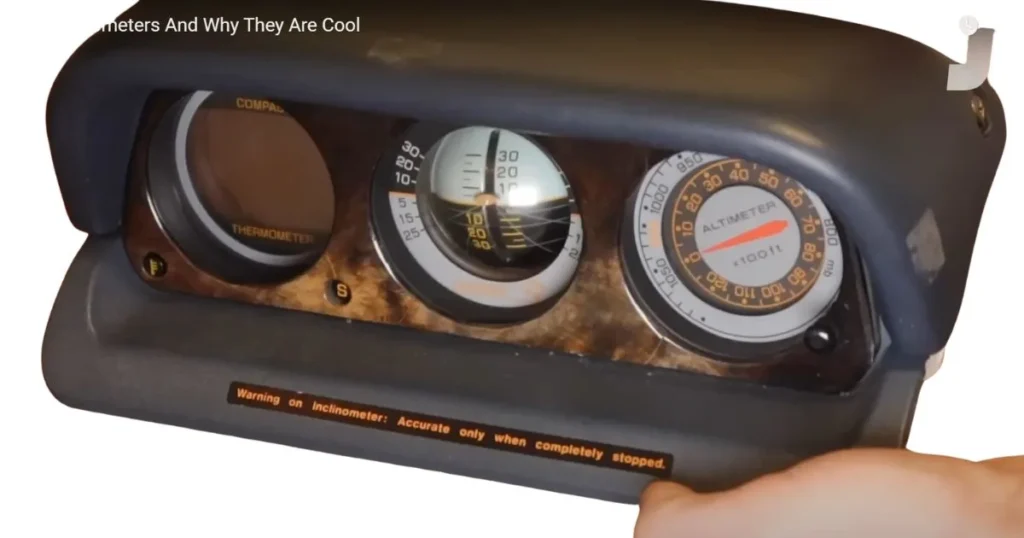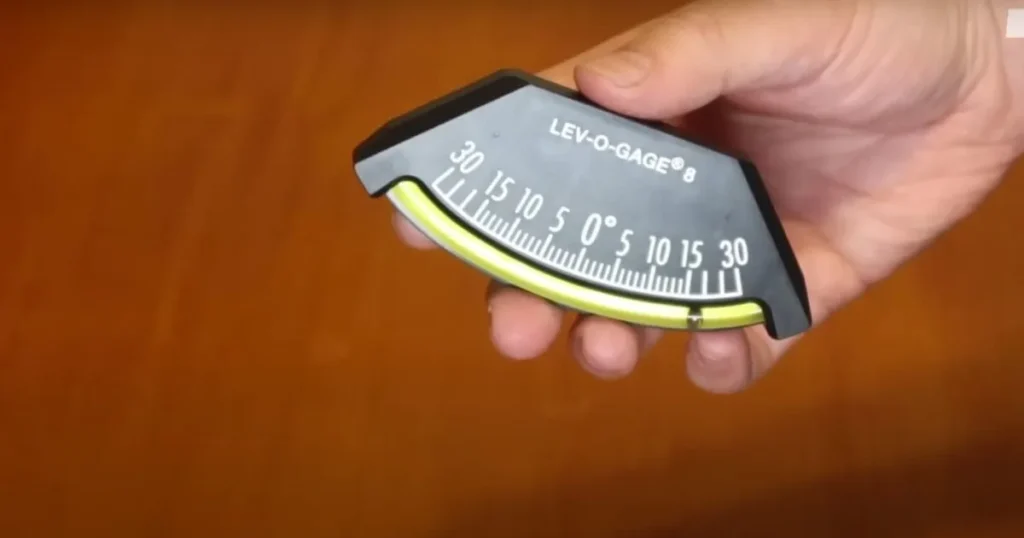
To use a car clinometer, mount it on your dashboard and read the tilt angle while driving. Ensure it's calibrated for accurate readings.
A car clinometer, also known as an inclinometer, is an essential gadget for off-road enthusiasts. It provides real-time data on the vehicle's angle of ascent or descent and side tilt. This tool enhances safety by helping drivers avoid potential rollovers on steep or uneven terrain.
Understanding your vehicle's limits becomes effortless with a clinometer, especially during adventurous trips in challenging conditions. It's a compact instrument that adds both functionality and a high-tech feel to your dashboard. With easy-to-read displays, drivers can make informed decisions to navigate safely through tricky off-road situations. Proper use of a clinometer increases the enjoyment and security of off-road driving adventures.
Introduction To Car Clinometer
Car clinometers reveal tilt and slope on the road. These devices guide drivers on uneven terrains. Understanding their workings can enhance driving safety.
What Is A Car Clinometer?
A car clinometer, or inclinometer, measures angles of slope. It shows pitch and roll of a vehicle. Off-road enthusiasts find this tool essential.
Why Use One?
- Enhance Safety: It alerts to dangerous tilt levels.
- Improve Off-Road Experience: Helps navigate steep inclines.
- Vehicle Care: Prevents undercarriage damage on trails.

Types Of Car Clinometer
Understanding Types of Car Clinometers is key for safe off-roading. These tools help drivers know how tilted or level their vehicle is. Let's explore the two main types: Analog and Digital.
Analog Vs. Digital
Both types serve the same purpose but differ in display and usage.
- Analog clinometers use a physical needle to show angles. They are simple and durable. No batteries required.
- Digital clinometers show angles on a screen. They offer more features like backlighting and precise readings. Batteries or car power needed.
Features To Look For
When choosing a car clinometer, consider these features:
| Feature | Importance |
|---|---|
| Accuracy | Ensures reliable readings. |
| Backlight | Helps in low light conditions. |
| Power Source | Choose battery or car powered. |
| Durability | Ensures long-term use. |
| Installation | Easy setup means less hassle. |
Installing Your Car Clinometer
Off-road enthusiasts know the value of a good car clinometer. It helps assess vehicle tilt and ensures safe navigation through tricky terrain. Proper installation is key for accurate readings. Let's install your car clinometer with ease.
Choosing The Right Location
Visibility and accessibility are crucial when selecting a spot for your clinometer. A location that doesn't obstruct the driver's view yet remains easily readable is ideal. Common choices are the dashboard or windshield, as they provide a clear line of sight.
- Dashboard: Near the center for easy glancing.
- Windshield: Top corner within the driver's reach.
Step-by-step Installation Guide
Follow these steps to ensure your clinometer is mounted correctly:
- Check the Package: Ensure all parts are present.
- Gather Tools: You might need a screwdriver or adhesive.
- Clean the Area: Remove dust and grime for a secure fit.
- Position Clinometer: Place it temporarily to check the view.
- Fix in Place: Use screws or adhesive strips to secure it.
- Calibrate: Follow the manual to adjust for accuracy.
- Test: Drive on a level surface to check its performance.

Reading A Car Clinometer
A car clinometer is an essential tool for off-road enthusiasts. It measures your vehicle's angle relative to the ground. This helps prevent rollovers. Learn to read one and enhance your off-road safety.
Understanding The Car Clinometer Display
Car clinometers show tilt and pitch. The display has two axes. The horizontal axis reads side tilt. The vertical axis reads forward or backward tilt. Some models use digital screens. Others use analog displays with a moving liquid.
Interpreting Angles And Slopes
Reading the angles is straightforward. A level ground reading is zero degrees. Positive numbers indicate upward slopes. Negative numbers show downward slopes. Side tilts work similarly. Right tilts show positive. Left tilts show negative. Know your vehicle's limits. This keeps you safe.
| Angle | Type | Description |
|---|---|---|
| 0° | Level | Flat ground |
| +15° | Upward Slope | Rising terrain ahead |
| -10° | Downward Slope | Descending terrain ahead |
| +20° | Right Tilt | Vehicle tilting right |
| -20° | Left Tilt | Vehicle tilting left |
Practice makes perfect. Use your clinometer often. Get familiar with readings. Soon, interpreting your clinometer will be second nature. Stay safe and enjoy the off-road adventure.
Practical Applications
Understanding the tilt and pitch of a vehicle is crucial. A car clinometer makes this easy. Off-roaders and everyday drivers can benefit from this tool. Here's how:
Off-roading Adventures
Thrill-seekers need to know their vehicle's limits. A clinometer provides this data. It helps drivers navigate steep hills and rough terrains safely. With a clinometer, adventurers can:
- Assess slopes before climbing or descending
- Monitor tilt angles to prevent rollovers
- Ensure vehicle stability on uneven ground
Daily Driving And Safety
Even on city roads, a clinometer is useful. It keeps drivers aware of their car's angle. This can be especially helpful on:
- Steep parking garages
- Sharp driveway inclines
- Icy or wet road conditions
By monitoring vehicle angle, drivers can:
- Avoid scraping the car's undercarriage
- Enhance safety during sudden stops
- Prevent accidents on slippery roads

Tips For Navigating Steep Slopes
Navigating steep slopes in a vehicle requires skill and the right tools. A car clinometer helps drivers understand the gradient of a slope. This tool ensures safety on challenging terrain. Here are some tips for handling steep inclines with a clinometer.
Assessing The Slope
Before tackling a slope, assess its steepness. Your clinometer will display the angle of the incline. This reading guides your approach.
- Read the clinometer carefully.
- Identify the maximum safe angle for your vehicle.
- Consider the surface condition.
Adjusting Your Approach
Adjust your driving based on the clinometer's reading. A right approach prevents rollovers. Use these steps:
- Approach the slope at a steady speed.
- Keep the vehicle centered on the path.
- Avoid sudden moves or sharp turns.
- Engage lower gears for more power.
- Use engine braking on descents.
Troubleshooting Common Issues
Using a car clinometer helps you understand your vehicle's tilt. Sometimes, you might face issues. Let's fix them together.
Calibration Problems
Calibration ensures your clinometer shows true angles. Incorrect readings mean calibration issues. Follow these steps:
- Place your car on a flat surface.
- Reset the clinometer to its factory settings.
- Follow the manufacturer's calibration guide.
If issues persist, consult the manual or contact support.
Visibility And Accuracy on Car Clinometer
Visibility and accuracy are crucial. Here's how to improve them:
- Ensure the clinometer is firmly mounted.
- Check for obstructions blocking the view.
- Use during daylight for better visibility.
- Regularly clean the device's screen.
For accuracy, avoid extreme temperatures. They can affect readings.

Enhancing Your Experience
Enhancing Your Experience with a car clinometer involves more than just installation. It's about maximizing its potential. Here's how to get the most out of this handy gadget.
Complementary Car Clinometer Gadgets
Pairing your clinometer with the right devices can transform your drive. Consider these:
- GPS Navigator: For accurate location tracking.
- Dashboard Camera: To record your adventures.
- Off-Road App: Offers terrain data and tips.
Upgrading Your Car Clinometer
Boost your clinometer's performance with these upgrades:
- Digital Display: For clearer readings.
- Backlight: Helps in low light conditions.
- Wireless Connectivity: Syncs with other devices.
| Feature | Benefit |
|---|---|
| Calibration | Ensures accuracy |
| Mounting Options | Secures device in place |
With the right setup, your car clinometer can do wonders. It makes every trip safer and more enjoyable. Ready to hit the road?
Related Post
Top 7 Reasons Your Car Tachometer Might Be Out of Service: Critical Insights
Expert Tips: Master Car Maintenance with a Vacuum Gauge!
Car Temperature Gauge Drops: Quick Fixes & Tips
Why Your Car Water Temperature Meter Safeguards Engine Health
Conclusion
Mastering the use of a car clinometer can significantly enhance your off-road adventures. By keeping an eye on vehicle angles, you'll tackle steep inclines and declines with confidence. Embrace this tool for safer, more informed driving, and let every journey be a testament to your savvy navigation skills.
Enjoy the climb!
Disclosure
Some links may be affiliate links. That means we may earn a small commission at no extra cost to you.